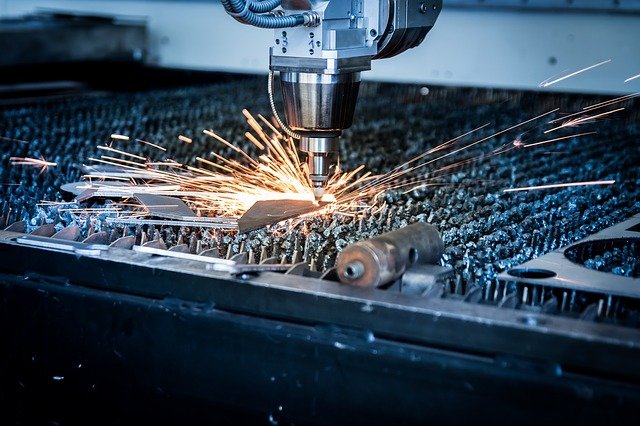There are now various options for advanced manufacturing, involving different techniques, including 3D printing and laser cutting.
Both provide the potential to rethink your manufacturing processes using digital technology, but which is better?
What Is Laser Cutting?
Laser cutting using high-powered laser technology for manufacturing.
With a laser cutting, you apply a column of high-density light, which has a single wavelength in the infrared part of the light spectrum. A laser resonator generates this very narrow beam, and the use of various mirrors can bounce it in different directions before it finally hits the plate.
You can focus the laser using a special lens, or a curved mirror, within the laser-cutting head of the tool.
It is important to focus the beam precisely, to ensure a perfectly consistent round spot that is at the centre of the laser-cutting nozzle.
The high-powered density of the tool results in the material you apply it to heating, melting, and even partially vapourising, at a rapid rate.
Along with various metals, you can laser-cut a wide range of materials, including:
- Acrylic
- Plywood
- MDF
- POM (polyoxymethylene)
- Paper and cardboard.
What Are The Benefits Of Laser Cutting?
It is possible to laser cut or engrave quite fine details while still creating large parts at a lower cost using laser cutting.
You can apply it to a wide variety of materials, and achieve precise results. It is a flexible, repeatable technique.
However, laser cutting only works on flat surfaces, so if you want a final 3D object, you will need to construct it out of several laser-cut components.
It also requires a specialist operator to make the most of its potential.
What Is 3D Printing?
3D printing transforms digital models into physical, three-dimensional objects by adding layer-upon-layer of material. This is why it is also known as additive manufacturing in industrial production.
It is very different to traditional manufacturing methods, such as machine-cutting or mould-making.
3D printing requires no specialist tools, because you manufacture parts directly onto a built platform, in layers.
This process begins with a digital 3D model which acts as the blueprint for the finished physical object. The dedicated 3D printing software will take this model and divide it into thin, two-dimensional layers and then transform these into a machine-language.
The printer will then use this language to process the information and output it through a nozzle, creating a three-dimensional object.
This process can involve various materials, but plastics are the most common. You can also 3D print metals.
Usually, post-printing, these objects will require some level of processing to achieve the right surface finish for their end-use.
What Are The Benefits Of 3D Printing?
3D printing is a highly effective prototyping method. It will produce prototypes of a very high quality, which can cut down on design and manufacturing costs considerably, and accelerate time to market.
It is also a versatile means of manufacturing finished products, at lower costs compared to traditional methods such as injection-moulding.
You can create complex designs with 3D printing, without having to construct them out of multiple parts.
The specialist materials available for 3D printing include:
- Polymers
- Resins
- Metals.
There are also materials with specific properties for end-applications, such as carbon fibre-reinforced materials. And you can customise individual parts without facing mounting costs.
Where 3D printing is not always competitive in price is in higher production volumes. 3D-printed objects may not possess the same tolerances as some bulk materials, as they are printed layer by layer.
However, there are increasing numbers of metal parts now being printed using 3D technology with superior mechanical properties.
Laser Cutting Or 3D Printing?
Both these techniques have their advantages, and which one is best for you will depend on what you want to design and manufacture.
But while you can see an entire project through, end-to-end using just one of these techniques, it may also be the case that you can maximise their effectiveness by using both.
For example, you might use 3D printing for rapid prototyping and creating specific components, but laser cutting for larger parts, and then bringing these different elements together in a finished product.
The important thing is to choose the best application for your end-purpose.
Talk to us about our 3D printing services, and how it can support your business. Call us on 01527 558 282, or complete our contact form and we’ll be in touch as soon as possible.







